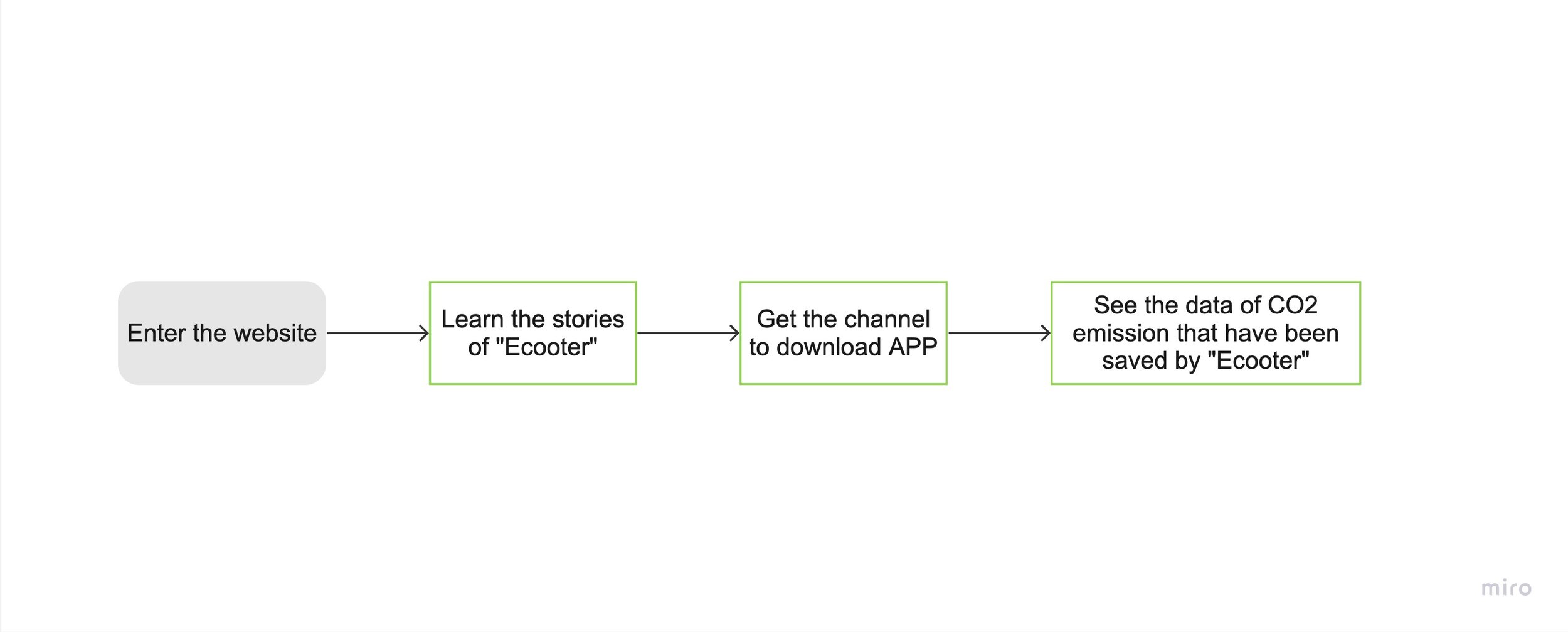
ecooter
type
UIUX Design
OVERVIEW
designer
Elaine Zeng
This project addresses the environmental impact of CO2 emissions by encouraging young people (18-25) to switch from oil-fueled cars to new energy scooters. Through an integrated approach involving an app, website, and digital billboards, it raises awareness of CO2 emissions, promotes positive driving experiences with electric vehicles, and offers a booking platform tailored to the preferences of younger users.
project brief
As the emission of CO2 mostly comes from our daily driving car's exhaust gas, we should pay attention to protecting our family: the earth. This project interacts with 3 mediums: apps, websites, and digital billboards to encourage and provide a convenient way for users to drive more scooters with new energy instead of oil-fueled cars to decrease the harmful gas to protect the environment.
problem
How could we encourage young people to use more new and energetic vehicles as they are not willing to drive intelligent cars compared with people from 26-35 years old people through the research?
design objectives
Let users know the impact of CO2 emission
Making users feel good experiences when they drive the electric cars
A suitable vehicle booking platform corresponded to 18-25 years old young people's tastes
solution
Step 1
Enter home page
Step 2
Find closest scooter
Step 3
Check details
Step 7
Take photo to lock
Step 4
Scan the code to ride
Step 8
Give the feedback
Step 5
Pay for using scooter
Step 9
Get report of CO2 saving
Step 6
Trip in progress
RESEARCH
I initiated my research by delving into the background of CO2 emissions. As of 2018, the annual CO2 emissions in the United States had surged to approximately 15.24 metric tons, with a continuous upward trend. The issue is particularly pronounced in New York City, where the situation is alarmingly severe. By the year 2020, the annual CO2 emissions in NYC had escalated to around 56.5 million tons.
CO2 emission in the U.S. each year (t)
reference
TOP 4 of main sources of CO2
CO2 emission in the New York City each year (t)
Failure to regulate CO2 emissions may lead to various detrimental effects, many of which have already emerged as significant global challenges:
Escalation of global warming
Proliferation of diseases
Rise in sea levels
Augmentation of sand deposits
Advancement of land desertification ....
According to the data from Chinadaily, the main sources of CO2 emissions come from
The United States has been a prominent emitter of greenhouse gases into the atmosphere for an extended period, surpassing other nations globally.
How does the world solve the problem of CO2 emission?
1. Europe
Across Europe, the governments of different nations have actively advocated for the widespread adoption of new energy vehicles. The European Commission has introduced a strategy known as Fit for 55, to reduce greenhouse gas emissions by 55% by 2030 (compared to 1990 levels) and attain carbon neutrality by 2050.
2. United States
President Biden of the United States signed an executive order at the White House, stipulating that by 2030, half of all new cars sold in the U.S. must be zero-emission vehicles. These zero-emission electric vehicles encompass pure electric vehicles, fuel cell vehicles, and plug-in hybrid vehicles.
Aligned with the global trend, our emphasis is on vehicles as the most accessible entities for safeguarding the Earth.
MARKETING RESEARCH
With the introduction of new energy-electric cars to the market, I conducted research on user preferences regarding the adoption of electric vehicles.
interview
opportunities
18-25 years old users preference
Individuals between the ages of 26 and 35 exhibit a preference for electric cars over oil-fueled vehicles. Conversely, those in the age group of 18 to 25 tend to favor oil-fueled cars over electric cars.
Despite the availability of new energy electric cars, there is a limited level of enthusiasm among users, particularly among the younger demographic.
The primary factors include the high cost of purchasing and charging electric cars, along with the challenge of finding charging locations. Additionally, some individuals perceive the experience with electric cars as less satisfactory compared to traditional oil-fueled vehicles.
In our effort to encourage more individuals to contribute to environmental protection through everyday actions, it becomes essential to identify and engage with additional "potential users." Addressing their specific needs and challenges related to electric vehicles can attract more users, thereby enhancing the societal impact of reducing CO2 emissions among those who are already inclined to drive electric cars.
26-35 years old users preference
persona
user journey map
Before finalizing the comprehensive user flow and addressing potential task situations users may encounter in "Ecooter", I analyzed the psychological enhancements experienced by users in various situations while engaging with the product.
user flow
APP: Renting the scooters and gathering data on the saved CO2 emissions based on the distances covered by users during the trip.
Website: A point of contact for users to download the app and understand the concept of Ecooter, including reporting data.
Digital billboard: Operational materials that function to report the data of CO2 emissions saved by Ecooter on a given day and promote the use of Ecooter as a means to contribute to environmental conservation.
REFLECTION
Professor Nigel Sielegar suggested we think about how to connect three platforms together to solve a social problem. Overall, this project not only enriched my design experience but also prompted me to contemplate how design can serve societal and environmental sustainability. Through the design of the electric vehicle rental system, I aspire to provide people with a convenient and eco-friendly transportation option, contributing collectively to the preservation of our planet.


























